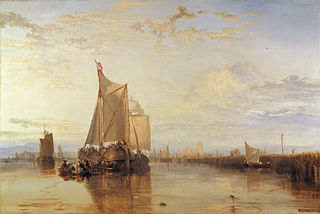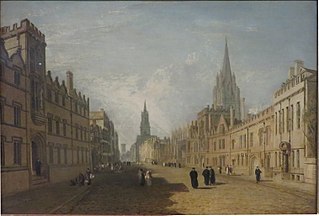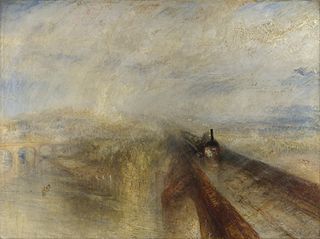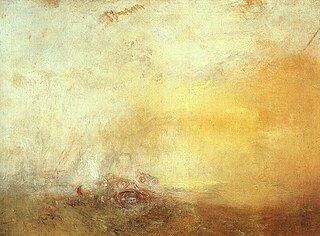 W
WThe Battle of Trafalgar, 21 October 1805 is an 1822 painting by British artist J. M. W. Turner. It was commissioned by King George IV as a part of a series of works to decorate three state reception rooms in St James's Palace and link the Hanoverian dynasty with military success. This work was Turner's only royal commission, and was to stand as the pendant piece to Philippe-Jacques de Loutherbourg's Lord Howe's action, or the Glorious First of June. This massive history painting measures 2,615 millimetres x 3,685 millimetres and was given to Greenwich Hospital shortly after its original installation. The painting now hangs in the National Maritime Museum, also in Greenwich, London.
 W
WThe Beacon Light is a painting by J. M. W. Turner. It was given to the National Museum of Wales by the Davies sisters. For some time it was regarded as a fake, but is now accepted as authentic.
 W
WThe Burning of the Houses of Lords and Commons is the title of two oil on canvas paintings by J. M. W. Turner, depicting the fire that broke out at the Houses of Parliament on the evening of 16 October 1834.
 W
WChichester Canal is a painting by the English Romantic landscape painter, watercolourist and printmaker J. M. W. Turner. It was painted in 1828 and was commissioned by George Wyndham, 3rd Earl of Egremont It is now in the Tate Collection.
 W
WDido building Carthage, or The Rise of the Carthaginian Empire is an oil on canvas painting by J. M. W. Turner. The painting is one of Turner's most important works, greatly influenced by the luminous classical landscapes of Claude Lorrain. Turner described it as his chef d'oeuvre. First exhibited at the Royal Academy summer exhibition in 1815, Turner kept the painting until he left it to the nation in the Turner Bequest. It has been held by the National Gallery in London since 1856.
 W
WDolbadarn Castle is an oil painting by J. M. W. Turner (1775–1851) depicting Dolbadarn Castle, created in 1798–1799. It is part of a body of work completed by Turner during a tour of the region, which included Dolbadarn, Llanberis and other parts of Snowdonia. Many supporting studies can be found in a sketch book now held by Tate Britain. When Turner returned to his London studio he developed these sketches into a number of more accomplished paintings of North Wales, including this one, which is now kept at the National Library of Wales.
 W
WThe Dort, or Dort or Dordrecht: The Dort packet-boat from Rotterdam becalmed is an 1818 painting by J M W Turner, based on drawings made by him in mid September 1817. It shows a view of the harbour of Dordrecht. It is the finest example of the influence of Dutch marine painting on Turner's work.
 W
WThe Fifth Plague of Egypt is an oil painting by Romantic English artist Joseph Mallord William Turner currently in the permanent collection at the Indianapolis Museum of Art. Despite its title, it depicts Moses cursing the Egyptians with a plague of hail and fire, known as the seventh plague.
 W
WThe Fighting Temeraire, tugged to her last berth to be broken up, 1838 is an oil painting by the English artist Joseph Mallord William Turner, painted in 1838 and exhibited at the Royal Academy in 1839.
 W
WFishermen at Sea, sometimes known as the Cholmeley Sea Piece, is an early oil painting by English artist J. M. W. Turner. It was exhibited at the Royal Academy in 1796 and has been owned by the Tate Gallery since 1972. The painting measures 36 by 48.125 inches. It was the first painting by Turner to be exhibited at the Royal Academy. It was praised by contemporary critics and founded Turner's reputation, as both an oil painter and a painter of maritime scenes. Art historian Andrew Wilton has commented that the image: "Is a summary of all that had been said about the sea by the artists of the 18th century."
 W
WThe Fountain of Indolence is an oil painting by the English artist J. M. W. Turner. First exhibited in 1834, it is now in the collection of the Beaverbrook Art Gallery in Fredericton, New Brunswick, Canada.
 W
WThe Golden Bough is a painting from 1834 by the English painter J. M. W. Turner. It depicts the episode of the golden bough from the Aeneid by Virgil. It is in the collection of the Tate galleries.
 W
WHigh Street, Oxford is an oil painting by J. M. W. Turner that was exhibited in 1810.
 W
WLight and Colour – The Morning after the Deluge – Moses Writing the Book of Genesis is an oil painting by the English painter Joseph Mallord William Turner (c.1775–1851), first exhibited in 1843.
 W
WModern Rome – Campo Vaccino is a landscape by British artist Joseph Mallord William Turner completed in 1839. It is Turner's final painting of Rome and had been in the possession of the family of the 5th Earl of Rosebery since 1878, until the painting came to auction, 7 July 2010. It was bought by the J. Paul Getty Museum, Los Angeles, and was subject to an export bar to allow a British gallery time to attempt to match the Getty's bid.
 W
WNorham Castle, Sunrise is an oil on canvas painting by English painter J. M. W. Turner, created around 1845. The painting was bequeathed to the National Gallery of British Art as part of the Turner Bequest in 1856. It remains in the collection to this day. Turner had created six different versions of this painting throughout his career and returned to Norham Castle multiple times to reflect on his work and life.
 W
WPort Ruysdael is an 1826 oil on canvas painting by the English painter J. M. W. Turner. It is in the collection of the Yale Center for British Art in New Haven.
 W
WRain, Steam and Speed – The Great Western Railway is an oil painting by the 19th-century British painter J. M. W. Turner.
 W
WIn 1842, British artist J. M. W. Turner painted three watercolours of the Rigi, a mountain in the Alps in Central Switzerland, which he had visited the previous summer. Widely regarded as some of his finest works, the watercolours capture the transitory effects of light and atmospheric conditions at the Rigi. According to John Ruskin, "Turner had never made any drawings [watercolours] like these before, and never made any like them again ... He is not showing his hand in these, but his heart."
 W
WRome, From Mount Aventine is an 1835 painting by J M W Turner, based on drawings made by him in the city in 1828. It shows a view of the city of Rome from the Aventine Hill.
 W
WThe Slave Ship, originally titled Slavers Throwing overboard the Dead and Dying—Typhoon coming on, is a painting by the British artist J. M. W. Turner, first exhibited at The Royal Academy of Arts in 1840. Measuring 35 3⁄4 in × 48 1⁄4 in in oil on canvas, it is now on display at the Museum of Fine Arts, Boston. In this classic example of a Romantic maritime painting, Turner depicts a ship visible in the background, sailing through a tumultuous sea of churning water and leaving scattered human forms floating in its wake. J.M.W. Turner was moved to paint The Slave Ship in 1840 after reading The History and Abolition of the Slave Trade by Thomas Clarkson. The events inspiring this image reveal the political motives that situate its exhibition in the midst of an international abolitionist campaign. As the piece has moved from public display to private ownership in London, to the Metropolitan Museum of Art, and then to the Museum of Fine Arts, it has gained a wide array of conflicting interpretations and criticisms over its allusion to the Zong massacre and painterly style. While the work is largely appraised for its spectacular atmospheric effects, there are conflicting opinions on whether the aestheticizing of the landscape overshadows the jarring subject matter or enhances it.
 W
WSnow Storm: Hannibal and his Army Crossing the Alps is an oil on canvas painting by J. M. W. Turner, first exhibited in 1812. Left to the nation in the Turner Bequest, it was acquired by the National Gallery in London in 1856, and is now held by the Tate Gallery.
 W
WSnow Storm, or Snow Storm: Steam-Boat off a Harbour's Mouth, is a painting by English artist Joseph Mallord William Turner (1775–1851) from 1842.
 W
WSunrise with Sea Monsters is an unfinished oil painting by English artist J. M. W. Turner.
 W
WUlysses Deriding Polyphemus is an 1829 oil painting by Joseph Mallord William Turner. It depicts a scene from Homer's Odyssey, showing Odysseus (Ulysses) standing on his ship deriding Polyphemus, one of the cyclopes he encounters and has recently blinded, who is disguised behind one of the mountains on the left side. Additional details include the Trojan Horse, a scene from Virgil's Aeneid, on one of the flags and the horses of Apollo rising above the horizon. The painting was exhibited at the Royal Academy of Arts in 1829. Acquired by the National Gallery in 1856, the painting is on display in room 34.
 W
WWar. The Exile and the Rock Limpet is an oil painting of 1842 by the English Romantic painter J. M. W. Turner (1775–1851). Intended to be a companion piece to Turner's Peace – Burial at Sea, War is a painting that depicts a moment from Napoleon Bonaparte's exile at Saint Helena. In December 1815, the former Emperor was taken by the British government to the Longwood House, despite its state of disrepair, to live in captivity; during his final years of isolation, Napoleon had fallen into despair. Turner's decision to pair the painting with Peace was heavily criticized when it was first exhibited but it is also seen as predecessor to his more famous piece Rain, Steam and Speed – The Great Western Railway (1844).
 W
WWhalers is an 1845 painting by British artist J. M. W. Turner. Done in oil on canvas, the work depicts a whaling ship and her launches pursuing a whale. Originally created with the hope that collector Elhanan Bicknell would purchase it, the work is currently found in the collection of the Metropolitan Museum of Art.
 W
W W
W